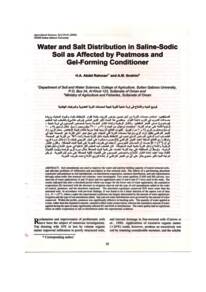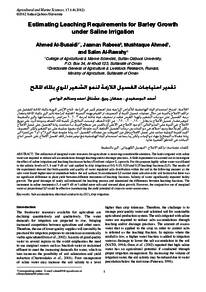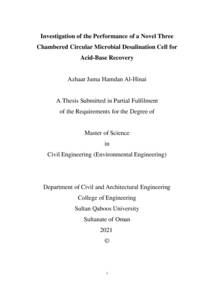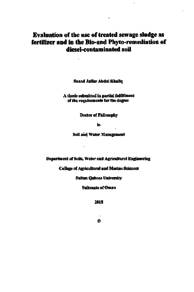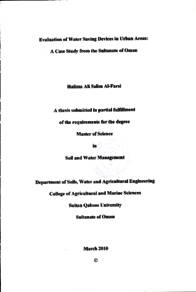Document
Water and salt distribution in saline-sodic soil as affected by peatmoss and gel-forming conditioner.
Contributors
Ibrahim, A. M., Author
Publisher
Sultan Qaboos university
Gregorian
2000
Language
English
English abstract
Soil amendments are used to improve the water and nutrient holding capacity of coarse textured soils, and alleviate problems of infīltration and percolation in fine textured soils. The effects of a gel-forming absorbent copolymer and peatmoss as soil amendments, on intermittent evaporation, moisture distribution, and salt redistribution through saline-sodic fine textured soil columns, were investigated. Two water qualities (3,600 and 560 µS/cm), two intervals of water applications (5 and 10 days) and two application rates (3 and 6 mm d-1) were used in the study. The results indicated that after a threshold period which was longer for the lower rate of water application, the cumulative evaporation (E) increased with the decrease in irrigation interval and the type of soil amendments added in the order of control, pcatmoss, and the absorbent copolymer. The absorbent copolymer conserved 30% more water than the untreated soils. In accordance with previous findings, E was found to be a linear function of the square root of time (i.e., E = c/t0.5), where c under the experimental conditions was largely determined by the amount of water applied per irrigation and the type of soil amendment added. Salt and soil water distributions were governed by the amount of water conserved. Within the profile, peatmoss was significantly effective in leaching salts. The quantity of water applied at a time, rather than the cumulative amount, seemed to affect water conservation; whereas the cumulative amount of water applied during the span of study significantly affected EC and SAR re-distributions. The water quality had no significant effect on either evaporation or salt re-distribution under the experimental condition.
Member of
ISSN
2410-1079
Resource URL
Citation
Abdel Rahman, H. A., & Ibrahim, A. M. (2000). Water and salt distribution in saline-sodic soil as affected by peatmoss and gel-forming conditioner. Journal of Agricultural and Marian Sciences, 5 (1), 35-41.
Arabic abstract
تستخدم محسنات التربة من أجل تحسين خواص التربات خشنة القوام للاحتفاظ بالماء والمواد المغذية، وزيادة معدلات التسرب في الترب ناعمة القوام. يستقصي هذا البحث تأثير اللدين الماص (مركب هلامي) والطحلب شبه المتفحم (بيتموس) على التبخر المتقطع، وانتشار الرطوبة وإعادة انتشار الملوحة ونسبة إدمصاص الصوديوم في تربة ملحية - قلوية قائمة على عوامد التربة. استخدمت نوعيتان من المياه ( 560 و 3600 ميكروسيمن/ سم) خلال ترددين (5 و 10 أيام ) ومعدلين للري (3 و 6 مم / اليوم). أظهرت النتائج أنه وبعد قيمة حرجة طالت نتيجة لانخفاض معدل الري، زاد التبخر التراكمي بتقليل تردد الري ونوعية محسنات التربة التي أضيفت على نسق تبخر أعلى للتربة غير المحسنة عنها في الطحلب ثم اللدين الماص الذي تسبب في الاحتفاظ بالمياه داخل التربة بنسبة زادت 30% من التربة غير المحسنة. وتوافقا مع النتائج السابقة اعتمد التبخر التراكمي (E) بصورة مباشرة على الجذر التربيعي للوقت (t) خلال دورة الري، أي أن (E = ct0.5) حيث أن المعامل التجريبي C يعتمد في ظروف التجربة على كمية المياه المضافة. واقترن انتشار الرطوبة والأملاح داخل التربة بكمية المياه المحفوظة. كان الطحلب شبه المتفحم أكثر فاعلية في غسيل الأملاح داخل قطاع التربة. ولوحظ أن المحافظة على مياه التربة اعتمدت على كمية المياه المضافة خلال دورة الري الواحدة وليست الكميات الكلية، بينما اعتمد إعادة انتشار الأملاح وإدمصاص الصوديوم على الكميات الكلية المضافة على مدى أيام التجربة. لم يكن لنوعية المياه تأثير معنوي يذكر على أي من التبخر التراكمي أو إعادة التوزيع الأملاح تحت ظروف التجربة.
Category
Journal articles

